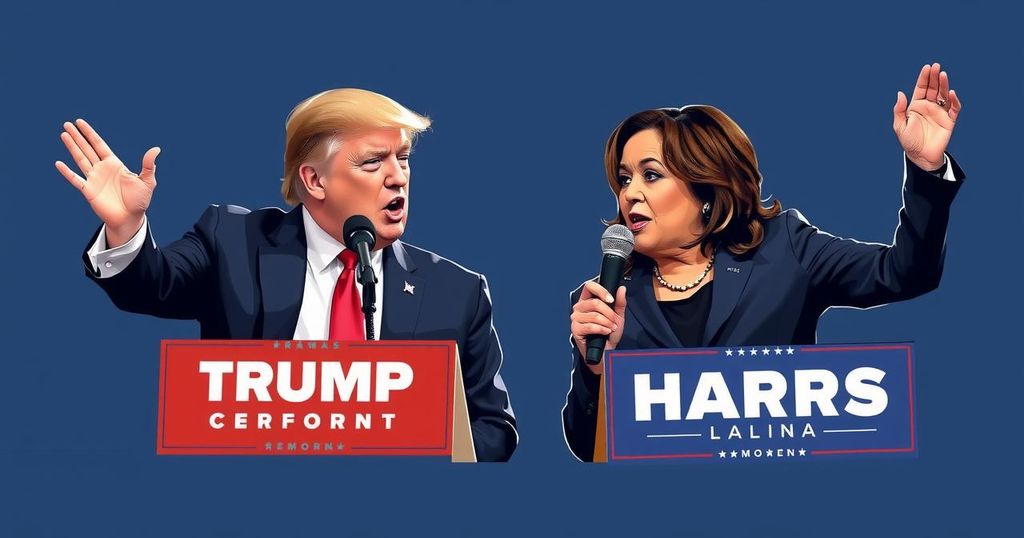Trump and Harris Compete for Latino Votes in Key Swing States

Kamala Harris and Donald Trump are intensifying their campaign strategies in Arizona and Nevada, focusing on securing Latino votes vital for their presidential aspirations. Polling shows Harris with 52 percent support among Hispanic voters, slightly ahead of Trump at 42 percent, highlighting the competitive nature of the race. Early voting trends indicate lower Latino turnout compared to other demographics, presenting challenges for both candidates as they seek to rally their support bases in this tightly contested election.
In the escalating campaign for the presidency, both Vice President Kamala Harris and former President Donald Trump are strategically focusing their efforts on the pivotal swing states of Arizona and Nevada, where the Latino vote could significantly influence the outcome of the election. Holding rallies in these states, both candidates are capitalizing on the growing Latino electorate, which comprises a record-high 14.7 percent of eligible voters this year and has historically leaned Democratic but has shown signs of increasing support for Republican candidates. On a recent Thursday, both candidates participated in events that underscored their differing approaches to engaging with Latino voters. Mr. Trump visited Albuquerque, New Mexico, a state he lost in the previous election but is using to bolster his credentials with Hispanic audiences. He remarked, “I’m here for one simple reason: I like you very much, and it’s good for my credentials with the Hispanic or Latino community.” Polling data reflect a competitive landscape; a recent New York Times/Siena poll indicates that Harris enjoys 52 percent support from Hispanic voters, while Trump has made gains, reaching 42 percent share among these voters. However, a controversial appearance by a comedian at a recent Trump rally has prompted backlash from some Latino leaders, complicating Trump’s outreach efforts. Furthermore, the increasing importance of early voting is evident, yet concerns are mounting regarding Latino turnout, which remains notably low compared to their share of eligible voters. In contrast, Black voters and women are showing greater enthusiasm in early voting, generating strategic implications for both candidacies as they traverse these critical states in the final stretch of the campaign. As the polls indicate a near tie in various swing states, including Pennsylvania and Nevada, the race appears increasingly reliant on the candidates’ ability to galvanize their respective traditional voting blocs. Political consultants emphasize that the performance of each party with their core demographics may ultimately determine the election’s victor. As both candidates aim to secure vital support from diverse voter groups, the culmination of their efforts in Arizona and Nevada will be essential in shaping the narrative leading up to Election Day.
The 2024 presidential election is increasingly competitive, with candidates Kamala Harris and Donald Trump focusing uniquely on engaging the Latino voter demographic in key swing states such as Arizona and Nevada. This demographic has the potential to sway the election due to their rising numbers among the eligible voting population. With a historical tendency to vote Democratic, there has been a noticeable shift toward Republican candidates in recent elections. The strategies employed by both candidates in addressing Latino concerns highlight the delicate balance they must maintain in a polarized political environment, particularly as demographics and voter turnout patterns evolve. Early voting statistics reveal disparities in voter turnout among different racial and ethnic groups, necessitating targeted campaign efforts as the election approaches.
In conclusion, the campaign strategies of Kamala Harris and Donald Trump underscore the significance of the Latino vote in swing states. While both candidates seek to increase their appeal to this growing demographic, recent polling suggests a tightening race, marking a potential shift in traditional voting patterns. With both parties keenly aware of the need to mobilize their bases while attracting undecided voters, the coming days will undoubtedly be crucial in determining the ultimate direction of the election.
Original Source: www.aljazeera.com





